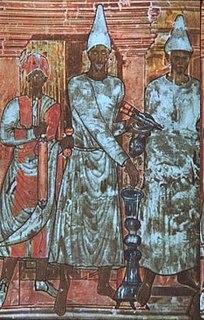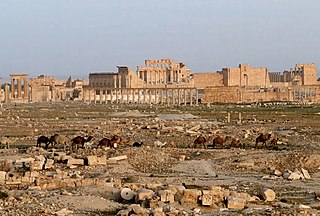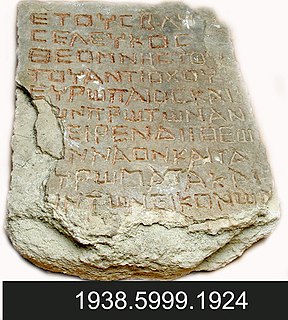
Atargatis or Ataratheh was the chief goddess of northern Syria in Classical antiquity. Ctesias also used the name Derketo for her, and the Romans called her Dea Syria, or in one word Deasura. Primarily she was a goddess of fertility, but, as the baalat ("mistress") of her city and people she was also responsible for their protection and well-being. Her chief sanctuary was at Hierapolis, modern Manbij, northeast of Aleppo, Syria.

Dura-Europos, also spelled Dura-Europus, was a Hellenistic, Parthian and Roman border city built on an escarpment 90 metres above the southwestern bank of the Euphrates river. It is located near the village of Salhiyé, in today's Syria. In 113 BC, Parthians conquered the city, and held it, with one brief Roman intermission, until 165 AD. Under Parthian rule, it became an important provincial administrative centre. The Romans decisively captured Dura-Europos in 165 AD and greatly enlarged it as their easternmost stronghold in Mesopotamia, until it was captured by the Sasanian Empire after a siege in 256–57 AD. Its population was deported, and after it was abandoned, it was covered by sand and mud and disappeared from sight.

The Dura-Europos synagogue was an ancient synagogue uncovered at Dura-Europos, Syria, in 1932. The synagogue contains a forecourt and house of assembly with painted walls depicting people and animals, and a Torah shrine in the western wall facing Jerusalem. It was built backing on to the city wall, which was important in its survival. The last phase of construction was dated by an Aramaic inscription to 244 AD, making it one of the oldest synagogues in the world. It was unique among the many ancient synagogues that have emerged from archaeological digs as the structure was preserved virtually intact, and it had extensive figurative wall-paintings, which came as a considerable surprise to scholars. These paintings are now displayed in the National Museum of Damascus.

The National Museum of Damascus is a museum in the heart of Damascus, Syria. As the country's national museum as well as its largest, this museum covers the entire range of Syrian history over a span of over 11 millennia. It displays various important artifacts, relics and major finds most notably from Mari, Ebla and Ugarit, three of Syria's most important ancient archaeological sites. Established in 1919, during King Faisal's Arab Kingdom of Syria, the museum is the oldest cultural heritage institution in Syria.

The Dura-Europos church is the earliest identified Christian house church. It is located in Dura-Europos in Syria. It is one of the earliest known Christian churches, and was apparently a normal domestic house converted for worship some time between 233 and 256, when the town was abandoned after conquest by the Persians. It is less famous, smaller, and more modestly decorated than the nearby Dura-Europos synagogue, though there are many other similarities between them.
The Feriale Duranum is a calendar of religious observances for a Roman military garrison at Dura-Europos on the Euphrates, Roman Syria, under the reign of Severus Alexander.

Parthian art was Iranian art made during the Parthian Empire from 247 BC to 224 AD, based in the Near East. It has a mixture of Persian and Hellenistic influences. For some time after the period of the Parthian Empire, art in its styles continued for some time. A typical feature of Parthian art is the frontality of the people shown. Even in narrative representations, the actors do not look at the object of their action, but at the viewer. These are features that anticipate the art of medieval Europe and Byzantium.

Yarhibol or Iarhibol is an Aramean god who was worshiped mainly in ancient Palmyra, a city in central Syria. He was depicted with a solar nimbus and styled "lord of the spring". He normally appears alongside Bel, who was a co-supreme god of Palmyra, and Aglibol, one of the other top Palmyrene gods.

Palmyra is an ancient Semitic city in present-day Homs Governorate, Syria. Archaeological finds date back to the Neolithic period, and documents first mention the city in the early second millennium BC. Palmyra changed hands on a number of occasions between different empires before becoming a subject of the Roman Empire in the first century AD.
The Bene Komare were a Palmyrene tribe who were attested as one of the main four tribes of Palmyra.
Jennifer Baird, is a British archaeologist and academic. She is Professor in Archaeology at Birkbeck, University of London. Her research focuses on the archaeology of Rome's eastern provinces, particularly the site of Dura-Europos.

The Temple of the Gadde is a double temple in the Syrian city of Dura-Europos, located near the agora. It was dedicated to the protective deities Gaddē of Dura-Europos and the nearby city of Palmyra. It was excavated between 1934 and January 1936 by the French/American expedition of Yale University, led by Michael Rostovtzeff.

The Temple of Zeus Theos at Dura Europos was built in the second century AD and was among the most important sanctuaries of the city. The structure was located in the centre of the settlement. It had an area of around 37 m2 and took up half an insula. It was excavated by an American-French team between December 1933 and March 1939.

The Temple of Adonis in Dura-Europos was discovered by a French-American expedition of Yale University led by Michael Rostovtzeff and was excavated between 1931 and 1934.

The Statue of Hercules was discovered in the Temple of Zeus Megistos in Dura-Europos during the 1935–1937 excavations undertaken by Yale University and the French Academy. The statue dates from the period of Roman rule at Dura-Europos. It is now in the possession of the Yale Art Gallery.

The so-called Dolicheneum is a temple in Dura Europos in the east of today's Syria, where Jupiter Dolichenus and god called Zeus Helios Mithras Turmasgade may have been worshiped. The remains of the temple were excavated in 1935/36, but results were never fully published.
The so-called necropolis temple of Dura Europos was in the north of the city, outside the city walls, about 150 m northwest of the main gate.

The Mithraeum of Dura Europos was found during excavations in the city in 1934. It is considered to be one of the best-preserved and best-documented cult buildings of Mithraism.

Sanctuary of Aphlad is located in the south-west of Dura Europos. It is the sanctuary of Aphlad, god of the city of Anath on the Euphrates, built by 54 CE.


















